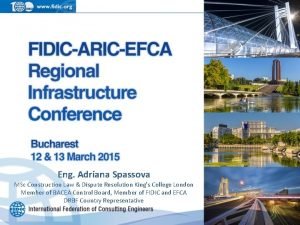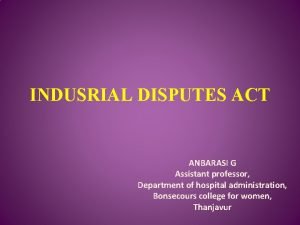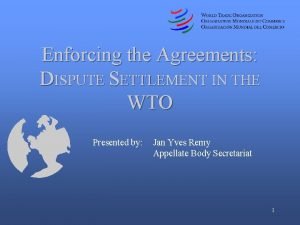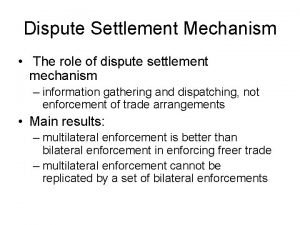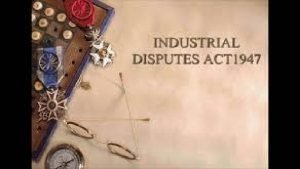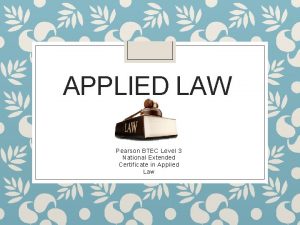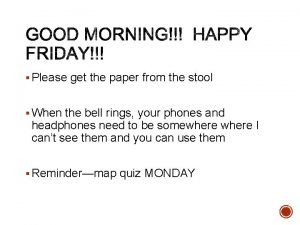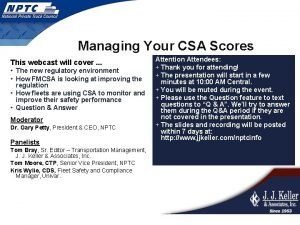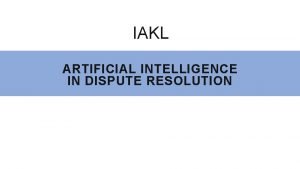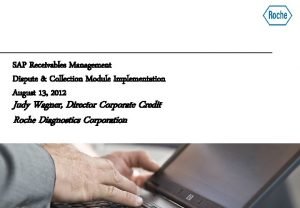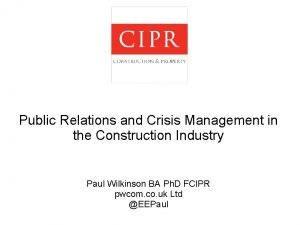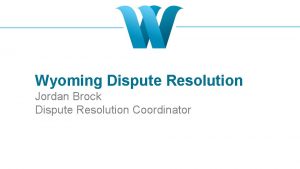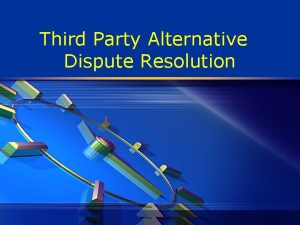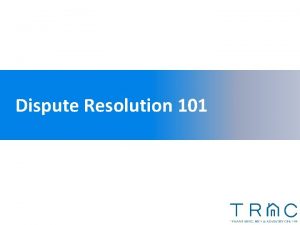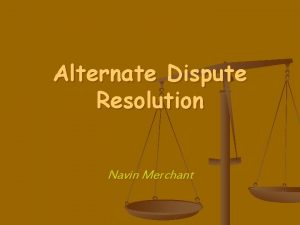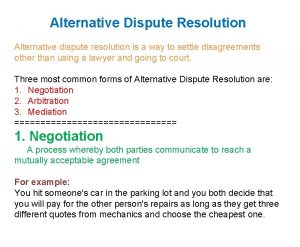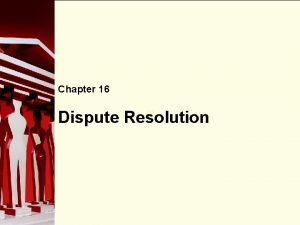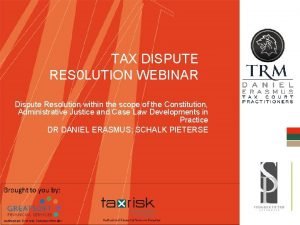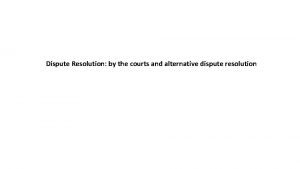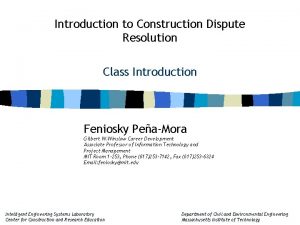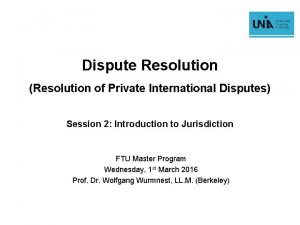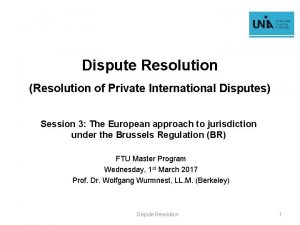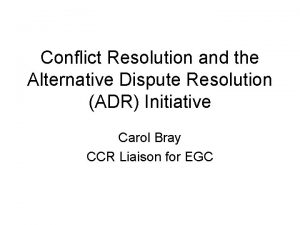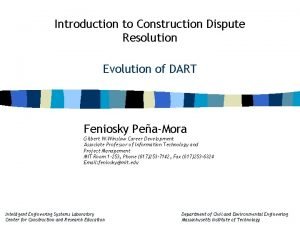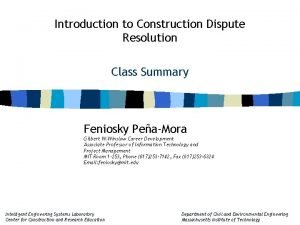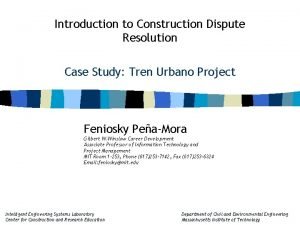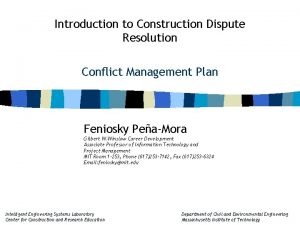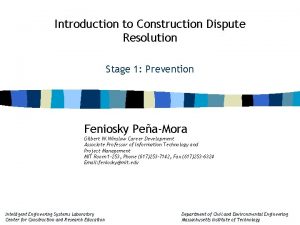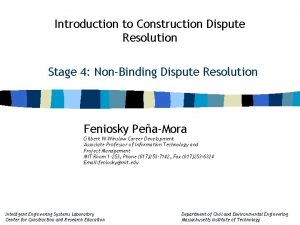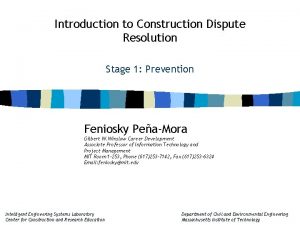Introduction to Construction Dispute Resolution The Construction Industry






































![References 39 n [Conlin et al. , 1996] : Conlin, J. , Langford, D. References 39 n [Conlin et al. , 1996] : Conlin, J. , Langford, D.](https://slidetodoc.com/presentation_image_h/2d4a56d85b733f5760df472e3bc93834/image-39.jpg)
- Slides: 39

Introduction to Construction Dispute Resolution The Construction Industry Feniosky Peña-Mora Gilbert W. Winslow Career Development Associate Professor of Information Technology and Project Management MIT Room 1 -253, Phone (617)253 -7142, Fax (617)253 -6324 Email: feniosky@mit. edu Intelligent Engineering Systems Laboratory Center for Construction and Research Education Department of Civil and Environmental Engineering Massachusetts Institute of Technology

Definitions n WHAT • One-time Unique Construction Projects • Over Three Trillion US Dollars of Investment n WHO • Owners, Engineers, Contractors, Suppliers • Different Roles and Objectives n WHY • Large, Complex and Unique Projects Susceptible to Conflicts n HOW • Understanding Organizational Issues and Uncertainties 2 • Defining Roles, Contractual Relationships and Delivery System Introduction to Construction Dispute Resolution Chapter 1: The Construction Industry © Peña-Mora, et. al. 2002

LNGT Project Organization BRITISH ENERGY CONGLOMERATE (CLIENT) Construction Management contract for Refinery Complex GERMAN DESIGN CONSTRUCTION HOLDING COMPANY CALIFORNIAN CONSTRUCTION MANAGER (CM) BRITISH DESIGN BUILD (fast-track) CONTRACTOR FOR LNG TANKS (DESIGNER) Formal Sub-contract agreement BID negotiations and TECHNICAL communications during construction Corporate bid and performance bonds for 100% of the work ITALIAN CONTRACTOR FOUNDATIONS AND CIVIL WORKS LNG TANKS (GC-civil) Formal communications and payment request to British firm Letter of intent to form joint venture, assuming 100% responsibility over cost and schedule for portion of work through corporate and personal guarantees VENEZUELAN SUB-CONTRACTOR ABOVE GRADE WORK PACKAGE CIVIL WORKS (SUB-civil) 3 Introduction to Construction Dispute Resolution Chapter 1: The Construction Industry © Peña-Mora, et. al. 2002

Project Communication Lines British DESIGNER California CM New York Arbitration Italian GC Job Formal lines of communication Informal lines of communications 4 Introduction to Construction Dispute Resolution Chapter 1: The Construction Industry © Peña-Mora, et. al. 2002

Case Study: Important Issues n Are the contractual and communicational relationships favorable to limit conflicts? n Is there anything about the project structure that would give an indication on how this project will handle conflicts? n Does this project have mechanisms to handle uncertainty in this project? n Is there a process by which conflicts on this project will be handled? 5 Introduction to Construction Dispute Resolution Chapter 1: The Construction Industry © Peña-Mora, et. al. 2002

Outline Ø Sources of Conflict and Dispute n Organizational Issues • Participants Issues • Project Structure • Process Problems n Project Uncertainty • External Uncertainties • Internal Uncertainties 6 Introduction to Construction Dispute Resolution Chapter 1: The Construction Industry © Peña-Mora, et. al. 2002

Sources of Conflict and Dispute n One-time Experience Projects n Correlated Variables: Difference between a Manufacturing Process and a Construction Project n Different Reasons for a Particular Dispute n Need to Identify the Roots of Controversy to Avoid Unnecessary Litigation 7 Introduction to Construction Dispute Resolution Chapter 1: The Construction Industry © Peña-Mora, et. al. 2002

Sources of Conflicts Research Author Sources of Conflicts and Disputes in Construction Bristow, 1998 Six Areas: unrealistic expectations; contract documents; communications; lack of team spirit; and changes. Conlin et al. , 1996 Five Areas: payment; performance; delay; negligence; quality; and administration. Heath et al. , 1994 Seven Areas: contract terms; payment; variations; time; nomination; renomination; and information. Hewit, 1991 Six Areas: change of scope; change conditions; delay; disruption; acceleration; and termination. Rhys Jones, 1994 Ten Areas: management; culture; communications; design economics; tendering pressures; law; unrealistic expectations; contracts; and workmanship. Semple et al. , 1996 Four Areas: acceleration; access; weather; and changes Sykes, 1996 Two Areas: misunderstandings; and unpredictability 8 Fenn et al. , 1997 Introduction to Construction Dispute Resolution Chapter 1: The Construction Industry © Peña-Mora, et. al. 2002

Hierarchical Sources of Conflicts Peña-Mora, et. al, 2002 9 Introduction to Construction Dispute Resolution Chapter 1: The Construction Industry © Peña-Mora, et. al. 2002

Owner-Contractor Objective Alignment n Disagreements Resulting from Incompatible Objectives Contractors’ and owners’ objectives Owners Objectives 10 Introduction to Construction Dispute Resolution Chapter 1: The Construction Industry © Peña-Mora, et. al. 2002

Contractors' Objectives n Achieve Profit and other Financial Gains n Satisfy Client and Generate Repeat Business n Manage Cash Flow n Limit Long-term Liability n Develop Employees and Create Satisfaction n Optimize Employment Level 11 Introduction to Construction Dispute Resolution Chapter 1: The Construction Industry © Peña-Mora, et. al. 2002

Owners' Objectives n Meet Return on Investment Goal n Minimize Operating and Maintenance Costs n Minimize Project Downtime and Outrages n Achieve High Product Quality n Provide Design Flexibility for Future Demands n Minimize Disruptions to Existing Operations n Avoid Negative Impact on Environment and Community n Reduce Design and Construction Time for a Timely Usage of the Facility 12 n Exceed Customer’s Expectations Introduction to Construction Dispute Resolution Chapter 1: The Construction Industry © Peña-Mora, et. al. 2002

Contractors’ and owners’ Objectives n Complete the Project within Budget n Complete the Project within Schedule n Maintain a High Level of Quality n Execute the Project Safely, without Wasted Time or Accidents n Minimize Claims and Litigation 13 Introduction to Construction Dispute Resolution Chapter 1: The Construction Industry © Peña-Mora, et. al. 2002

Outline ü Sources of Conflict and Dispute ü Organizational Issues Ø Participants Issues • Project Structure • Process Problems n Project Uncertainty • External Uncertainties • Internal Uncertainties 14 Introduction to Construction Dispute Resolution Chapter 1: The Construction Industry © Peña-Mora, et. al. 2002

Major Participants n Owner : Public and Private Owner n Architect/Engineer n General Contractor n Construction Manager 15 Introduction to Construction Dispute Resolution Chapter 1: The Construction Industry © Peña-Mora, et. al. 2002

Outline ü Sources of Conflict and Dispute ü Organizational Issues ü Participants Issues Ø Project Structure • Process Problems n Project Uncertainty • External Uncertainties • Internal Uncertainties 16 Introduction to Construction Dispute Resolution Chapter 1: The Construction Industry © Peña-Mora, et. al. 2002

Project Structure n Seven major project delivery systems • Traditional Design-Bid-Build (DBB) • Pure or Agency Construction Management (PCM) • Construction Management at Risk (CMR) • Design-Build (D/B) • Turn-Key (TKY) • Design-Build-Operate (DBO) • Build-Operate-Transfer (BOT) 17 Introduction to Construction Dispute Resolution Chapter 1: The Construction Industry © Peña-Mora, et. al. 2002

Four Main Delivery Systems: Relationships Between Participants Owner A/E General Contractor C/M Subcontractor Traditional Design-Bid-Build Trade contractor Construction Management at Risk 18 Trade contractor Owner A/E Trade contractor Pure or Agency Construction Management Owner C/M A/E Contractual Relationship Communicational Relationship Introduction to Construction Dispute Resolution Construction Function Sub contractor D/B Entity Design Function Sub contractor Design-Build Internal Relationship Chapter 1: The Construction Industry © Peña-Mora, et. al. 2002

Type of Relationships Among Participants 19 Introduction to Construction Dispute Resolution Chapter 1: The Construction Industry © Peña-Mora, et. al. 2002

Traditional Design-Bid-Build Owner A/E General Contractor Subcontractor Contractual Relationship Communicational Relationship 20 Introduction to Construction Dispute Resolution Chapter 1: The Construction Industry © Peña-Mora, et. al. 2002

Traditional Design-Bid-Build n Sequential Construction Process n Lump Bids Commonly Adopted, Resulting in Adversarial Relationship between the Owner and the Contractor n Collaborative Relationship between A/E(Chosen on Qualification Basis) and Owner n Different Participants’ Interests: • Owner: Quality and Value Product, Delivery Schedule, Site Safety • Contractor: Profit, Construction Time, Relationships, Reputation 21 • A/E: Profit, Aesthetics, Relationships, Quality, Recognition Introduction to Construction Dispute Resolution Chapter 1: The Construction Industry © Peña-Mora, et. al. 2002

Pure Construction Management Owner C/M Trade contractor A/E Trade contractor Contractual Relationship Communicational Relationship 22 Introduction to Construction Dispute Resolution Chapter 1: The Construction Industry © Peña-Mora, et. al. 2002

Pure Construction Management n Great Flexibility in the Schedule and for Changes n Market Competition for the Work n Fiduciary Relationship with the Contractor n Small Financial Risks of PCM and High Risk of Loss of Reputation n PCM Generally Paid a Fixed Fee n PCM as Facilitator/Mediator in Conflicts 23 Introduction to Construction Dispute Resolution Chapter 1: The Construction Industry © Peña-Mora, et. al. 2002

Construction Management at Risk Owner C/M Trade contractor A/E Trade contractor Contractual Relationship Communicational Relationship 24 Introduction to Construction Dispute Resolution Chapter 1: The Construction Industry © Peña-Mora, et. al. 2002

Construction Management at Risk n CM Guaranteeing Maximum Price: GMP n Reduced Owner’s Risk n Half-way between the DBB and the PCM System n Contractual Relationships between CM and Trade Contractors 25 Introduction to Construction Dispute Resolution Chapter 1: The Construction Industry © Peña-Mora, et. al. 2002

Design-Build Owner Construction Function Sub contractor D/B Entity Sub contractor Design Function Sub contractor Contractual Relationship Communicational Relationship Internal Relationship 26 Introduction to Construction Dispute Resolution Chapter 1: The Construction Industry © Peña-Mora, et. al. 2002

Design-Build n One Contractual Team Responsible for Design and Construction Function n Owners with more Emphasis on Schedule Despite Less Control and More Uncertainty of Cost n Loss of Control Over Design and Flexibility in Changes n Owner with Enough Knowledge about Design and Construction to Establish the Initial Parameters, Review Proposals and Monitor the Process 27 Introduction to Construction Dispute Resolution Chapter 1: The Construction Industry © Peña-Mora, et. al. 2002

Outline ü Sources of Conflict and Dispute ü Organizational Issues ü Participants Issues ü Project Structure Ø Process Problems n Project Uncertainty • External Uncertainties • Internal Uncertainties 28 Introduction to Construction Dispute Resolution Chapter 1: The Construction Industry © Peña-Mora, et. al. 2002

Process Problems n Process Problems Inherited from the Choice of Project Structure and Contract Type n Distinction between Contract Type and Delivery Process 29 Introduction to Construction Dispute Resolution Chapter 1: The Construction Industry © Peña-Mora, et. al. 2002

Contract Types n Lump Sum or Fixed Price Contract • Most Common and Most Adversarial n Cost plus Contract • Risk Shifted to the Owner • Risk of Cost Inflation by the Contractor to Increase Profit n Guaranteed Maximum Price • Cost Reimbursement plus Profit, with a Fixed Ceiling 30 Introduction to Construction Dispute Resolution Chapter 1: The Construction Industry © Peña-Mora, et. al. 2002

Outline ü Sources of Conflict and Dispute ü Organizational Issues ü Participants Issues ü Project Structure ü Process Problems ü Project Uncertainty Ø External Uncertainties • Internal Uncertainties 31 Introduction to Construction Dispute Resolution Chapter 1: The Construction Industry © Peña-Mora, et. al. 2002

External Uncertainties n Result of External Forces on the Project: Inclement Weather, Political Risk, Acts of God n Some Issues Addressed with Insurance Policies, Contract Clauses or Other Forms of Mitigation n Identify the Type of Uncertainties ahead of Time and Account for Them to Avoid Conflict 32 Introduction to Construction Dispute Resolution Chapter 1: The Construction Industry © Peña-Mora, et. al. 2002

Outline ü Sources of Conflict and Dispute ü Organizational Issues ü Participants Issues ü Project Structure ü Process Problems ü Project Uncertainty ü External Uncertainties Ø Internal Uncertainties 33 Introduction to Construction Dispute Resolution Chapter 1: The Construction Industry © Peña-Mora, et. al. 2002

Internal Uncertainties n Errors in Design, Unforeseen Site Conditions, Incomplete Definition of Scope n Need for a Proper Monitoring and Control to Reduce the Impact of Internal Uncertainties 34 Introduction to Construction Dispute Resolution Chapter 1: The Construction Industry © Peña-Mora, et. al. 2002

Outline ü Sources of Conflict and Dispute ü Organizational Issues ü Participants Issues ü Project Structure ü Process Problems ü Project Uncertainty ü External Uncertainties ü Internal Uncertainties 35 Introduction to Construction Dispute Resolution Chapter 1: The Construction Industry © Peña-Mora, et. al. 2002

Conflicts in LNGT Project n Omission of Civil Works Contract between DESIGNER and GC n Misplacement of the Contract between GC and SUB n Cash Flow Problems and Cost Overruns : The SUB invoicing 55% of the Contract to the GC while only 30% is in Place 36 Introduction to Construction Dispute Resolution Chapter 1: The Construction Industry © Peña-Mora, et. al. 2002

Remedies and Consequences n DESIGNER’s Takeover of GC’s and SUB’s Work n GC and SUB’s Responsibility For All Costs Going Forward Concerning the Civil Works Package n DESIGNER with Total Control of the Project and GC and SUB Assuming the Cost Risk n Consequences • One Year Delay • Increase in Overhead Cost • Claims for Changed Site Conditions and Design Changes Issued by GC and SUB against DESIGNER • Counterclaims 37 • Arbitration in New York with High Expenses Introduction to Construction Dispute Resolution Chapter 1: The Construction Industry © Peña-Mora, et. al. 2002

Summary n Conflict in the Construction Industry Is Inherent of the Characteristics of the Industry. n Project Uncertainties and Sub-optimal Contractual Relationships Are a Major Source of Conflict. n Legal Costs of Dispute Resolution Constitute a Burden for the Industry. n Dispute Avoidance and Resolution Techniques Should Be Implemented to Resolve Conflicts With Time and Cost Savings. 38 Introduction to Construction Dispute Resolution Chapter 1: The Construction Industry © Peña-Mora, et. al. 2002
![References 39 n Conlin et al 1996 Conlin J Langford D References 39 n [Conlin et al. , 1996] : Conlin, J. , Langford, D.](https://slidetodoc.com/presentation_image_h/2d4a56d85b733f5760df472e3bc93834/image-39.jpg)
References 39 n [Conlin et al. , 1996] : Conlin, J. , Langford, D. A. , and Kennedy, P. , 1996. The Relationship Between Construction Procurement Strategies and Construction Contract Disputes Proceedings of CIB W 92, North Meets South, pp. 66 -82. Durban, (January). n [Fenn et al. , 1997] : Fenn, Peter, Lowe, David, and Speck Christopher, (1997). Conflict and Dispute in Construction Management and Economics (1997) 15, p. 513 n [Gordon, 1991] : Gordon, Chris. (1991). “Compatibility of Construction Contracting Methods with Projects and Owners” MS Thesis, MIT, Cambridge. n [Howell et al. , 1998] : n [Peña-Mora et al, 2002] : Peña-Mora, F. , Sosa, C. , and Mc. Cone, S. Introduction to Construction Dispute Resolution. Prentice Hall, New Jersey, 2002. n [Porter, 1985] : Porter, M. (1985). Competitive Advantage, Free Press, New York. n [Scott, 1995] : Scott, Donahey M. , (1995). Seeking Harmony. Technique Dispute Resolution Journal. pp. 74 -78. April-June n [Stipanowich, 1996] : Stipanowich, Thomas J. , (1996). Arbitration: Innovation and Evolution in the United States Construction Industry. Wake Forest Law Review Vol. 31 (1) pp. 65 -182. Spring n [Sykes, 1996] : Sykes, John. Claims and Disputes in Construction: Suggestions for their Timely Resolution. Construction Law Journal. Sweet & Maxwell. Vol. 12 (1) pp. 3 -13 Introduction to Construction Dispute Resolution Chapter 1: The Construction Industry © Peña-Mora, et. al. 2002
 Msc construction law and dispute resolution
Msc construction law and dispute resolution High resolution low resolution
High resolution low resolution What is labour law in india
What is labour law in india Krishna godavari dispute
Krishna godavari dispute Objectives of industrial dispute act 1947
Objectives of industrial dispute act 1947 Wto dispute settlement mechanism
Wto dispute settlement mechanism Dispute settlement mechanism meaning
Dispute settlement mechanism meaning Rights dispute
Rights dispute Objectives of industrial dispute act 1947
Objectives of industrial dispute act 1947 Maine canada border dispute
Maine canada border dispute Btec applied law
Btec applied law Relic boundary
Relic boundary Financial education services compensation plan
Financial education services compensation plan Territorial morphology definition
Territorial morphology definition Gary petty sms
Gary petty sms Phyrrho investments it s an english predictive coding case
Phyrrho investments it s an english predictive coding case Delay and dispute mitigation
Delay and dispute mitigation Sap receivables management
Sap receivables management Dispute management in order to cash
Dispute management in order to cash Impact of gst on construction industry
Impact of gst on construction industry 2nd page
2nd page Accidents in construction industry
Accidents in construction industry Hình ảnh bộ gõ cơ thể búng tay
Hình ảnh bộ gõ cơ thể búng tay Slidetodoc
Slidetodoc Bổ thể
Bổ thể Tỉ lệ cơ thể trẻ em
Tỉ lệ cơ thể trẻ em Voi kéo gỗ như thế nào
Voi kéo gỗ như thế nào Tư thế worms-breton
Tư thế worms-breton Chúa yêu trần thế alleluia
Chúa yêu trần thế alleluia Các môn thể thao bắt đầu bằng tiếng đua
Các môn thể thao bắt đầu bằng tiếng đua Thế nào là hệ số cao nhất
Thế nào là hệ số cao nhất Các châu lục và đại dương trên thế giới
Các châu lục và đại dương trên thế giới Công của trọng lực
Công của trọng lực Trời xanh đây là của chúng ta thể thơ
Trời xanh đây là của chúng ta thể thơ Mật thư anh em như thể tay chân
Mật thư anh em như thể tay chân 101012 bằng
101012 bằng Phản ứng thế ankan
Phản ứng thế ankan Các châu lục và đại dương trên thế giới
Các châu lục và đại dương trên thế giới Thể thơ truyền thống
Thể thơ truyền thống Quá trình desamine hóa có thể tạo ra
Quá trình desamine hóa có thể tạo ra
